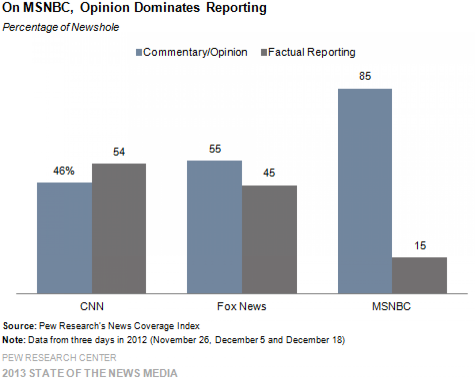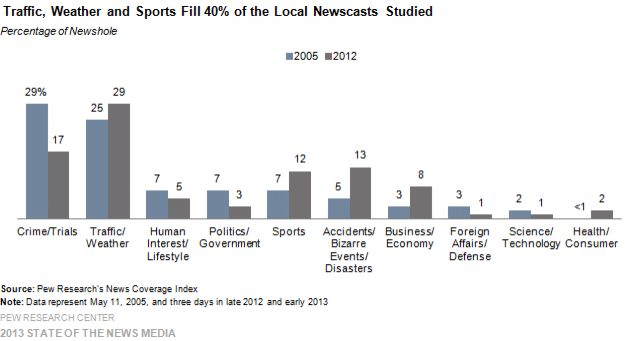Fox News Is More Fair And Balanced Than MSNBC?

Fox News Channel’s “Fair and Balanced” tagline has long been seen as a ridiculous assertion by its left-leaning critics, but the conservative cable giant may do a better job of straight reporting than its liberal counterpart, MSNBC.
That is one of the many takeaways gleaned from the Pew Research Center’s annual “State of the News Media” report, which examines a wealth of data on the television news industry in a section called “The Changing TV News Landscape.” According to the report, released on Monday by Pew’s Project for Excellence in Journalism,” MSNBC devoted a mere 15 percent of its airtime to factual reporting during a three days of specified programming last year. The other 85 percent was devoted to commentary and opinion -- a statistic that will not surprise viewers who spent any time with Rachel Maddow during the presidential election.
During the same three-day period, Fox News devoted 45 percent of its airtime to factual reporting and 55 percent to commentary and opinion. Conversely, the proudly objective CNN was the only network that dedicated more of its airtime to straight news than punditry -- 54 percent compared with 46 percent. But at the same time, the network has cut back on its in-depth stories and coverage of live events.
According to Pew, an individual story was considered commentary or opinion if it included opinionated statements 25 percent of the time. If not, the story was considered a factually reported piece. The report does not mention if researchers took into account whether factual stories were reported with bias, just that MSNBC devoted more airtime to content that was packaged as commentary.
MSNBC is owned by NBCUniversal, a unit of Comcast Corp. (NASDAQ:CMCSA), and Fox is owned by News Corp. (NASDAQ:NWSA). CNN is part of the Turner Broadcasting System, which is owned by Time Warner Inc. (NYSE:TWX). For the above percentages, Pew compiled data from each of the three networks for three different days last year: Nov. 26, Dec. 5 and Dec. 18. The study’s authors -- Mark Jurkowitz, Paul Hitlin, Amy Mitchell, Laura Santhanam, Steve Adams, Monica Anderson and Nancy Vogt -- say the results suggest a cable news industry in a state of flux.
The three rival networks, which continue to position themselves against each other, look a lot more similar today than they did five years ago, according to the study’s authors. “At the same time,” they wrote, “some of the differences that demarcated daytime cable from prime time have also eroded in the past five years. Traditionally known for its attention to breaking news, daytime cable’s cuts in live event coverage and its growing reliance on interviews suggest it may be moving more toward the talk-oriented evening shows.”

That cable news is in flux will come as no surprise to many who work in the industry. CNN, which logged record-low ratings last summer, is currently undergoing a major shake-up at the hands of Jeff Zucker, the new president of CNN Worldwide. Zucker has sworn to “remain true to the journalistic values that have always been the hallmark of CNN,” but, in the meantime, he has been swapping out familiar faces for fresh talent at lightning speed. Even Fox News, which is still the ratings leader among the three, has seen significant audience erosion since the reelection of President Barack Obama.
Despite such turmoil, cable news networks remain highly profitable for their corporate parents, and the cable news industry is in decidedly better shape than local television news. According to the Pew study, local affiliates for the major broadcasters -- ABC, NBC, CBS and Fox -- lost 6 percent of their audiences for morning, evening and late-night newscasts in 2012. Advertising revenue last year was down significantly from a decade ago, despite record-high spending on political ads during the presidential campaign. And in what Pew researches are calling “shrinking pains,” the effects of those dwindling resources are starting to show. Hard-hitting news stories covering local politics and crime have diminished, while sports, weather and traffic now make up some 40 percent of local newscasts’ airtime.

Monday’s report is the 10th edition of Pew’s “State of the News Media.” The full report covers TV news, magazines, newspapers, digital media, audio and the alternative press. Read the full report here. And if you care about the news industry, prepare to get depressed.
Got a news tip? Send me an email. Follow me on Twitter: @christopherzara
© Copyright IBTimes 2024. All rights reserved.






















